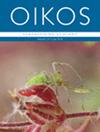Availability of mates and food influence the plasticity in strategies mediating life‐history tradeoffs in an insect
IF 3
2区 环境科学与生态学
Q2 ECOLOGY
引用次数: 0
Abstract
Different life‐history strategies can be employed to navigate the tradeoff between investment into reproductive and somatic tissues, and plasticity in life‐history strategies may be one of animals' most important tools to counter ongoing global change. Therefore, we factorially manipulated the availability of two critical resources – mates and food – to determine plasticity in life‐history investment strategies. We tested several hypotheses using females of the variable field cricket Gryllus lineaticeps because it exhibits a wing dimorphism that mediates a tradeoff between investment into ovary mass and dispersal (flight capacity) during early adulthood – long‐winged females' investment into flight muscle obligates reduced ovaries, while short‐winged females lack flight but instead heavily invest into ovaries. The availability of food and mates played different roles in the plasticity of life‐history strategies. Song exposure as a proxy for mate density exerted its strongest (negative) effects on somatic tissue and flight capacity. Meanwhile, food availability strongly influenced food intake, which exerted its strongest (positive) effects on reproduction. Raw traits of reproductive and somatic investment, such as ovary and non‐ovary mass gained, respectively, positively covaried; yet, reproduction‐soma relationships disappeared or became negative (i.e. characterizing tradeoffs) when resource (food) acquisition was accounted for. Thus, failure to account for food intake can lead to misdiagnoses of the plasticity of reproduction‐related tradeoffs. Further, the negative effect of flight capacity on ovary mass gain was dependent on male song (acoustic × flight interaction) and food availability (food × flight interaction). These were likely adaptive responses because they allowed flight‐capable females to invest heavily into reproduction when conditions for reproduction were favorable (i.e. abundance of food and mates). In sum, we uncovered multi‐directional effects among dispersal capacity, resource availability, and the plasticity of the tradeoff between investment into reproductive and non‐reproductive tissues.配偶和食物的可获得性影响昆虫生命史权衡策略的可塑性
动物可以采用不同的生活史策略来权衡对生殖组织和躯体组织的投资,而生活史策略的可塑性可能是动物应对当前全球变化的最重要工具之一。因此,我们对配偶和食物这两种关键资源的可用性进行了因素操纵,以确定生命史投资策略的可塑性。我们利用可变田蟋蟀(Gryllus lineaticeps)的雌性来检验几个假设,因为这种蟋蟀在成年早期表现出翅膀二形性,这种二形性介导了对卵巢质量和分散能力(飞行能力)投资之间的权衡--长翅雌性对飞行肌肉的投资必须减少卵巢,而短翅雌性缺乏飞行能力,但却对卵巢进行大量投资。食物和配偶的可获得性对生活史策略的可塑性起着不同的作用。作为配偶密度替代物的歌声暴露对躯体组织和飞行能力的影响最大(负面)。同时,食物的可获得性对食物摄入量有很大影响,而食物摄入量对繁殖有最强的(正)影响。生殖和躯体投资的原始特征,如卵巢和非卵巢质量的增加,分别呈正协方差;然而,当考虑到资源(食物)的获取时,生殖与躯体的关系消失或变为负相关(即权衡的特征)。因此,如果不考虑食物摄入量,可能会导致对繁殖相关权衡的可塑性的误诊。此外,飞行能力对卵巢质量增加的负面影响取决于雄性鸣唱(声音×飞行交互作用)和食物供应(食物×飞行交互作用)。这些可能都是适应性反应,因为当繁殖条件有利(即食物和配偶丰富)时,有飞行能力的雌性可以将大量精力投入到繁殖中。总之,我们发现了扩散能力、资源可用性以及生殖和非生殖组织投资权衡的可塑性之间的多向效应。
本文章由计算机程序翻译,如有差异,请以英文原文为准。
求助全文
约1分钟内获得全文
求助全文
来源期刊

Oikos
环境科学-生态学
CiteScore
6.20
自引率
5.90%
发文量
152
审稿时长
6-12 weeks
期刊介绍:
Oikos publishes original and innovative research on all aspects of ecology, defined as organism-environment interactions at various spatiotemporal scales, so including macroecology and evolutionary ecology. Emphasis is on theoretical and empirical work aimed at generalization and synthesis across taxa, systems and ecological disciplines. Papers can contribute to new developments in ecology by reporting novel theory or critical empirical results, and "synthesis" can include developing new theory, tests of general hypotheses, or bringing together established or emerging areas of ecology. Confirming or extending the established literature, by for example showing results that are novel for a new taxon, or purely applied research, is given low priority.
 求助内容:
求助内容: 应助结果提醒方式:
应助结果提醒方式:


